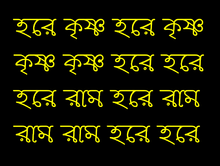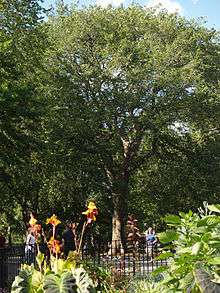Hare Krishna (mantra)
.png)

The Hare Krishna mantra, also referred to reverentially as the Maha Mantra ("Great Mantra"), is a 16-word Vaishnava mantra which is mentioned in the Kali-Santarana Upanishad, and which from the 15th century rose to importance in the Bhakti movement following the teachings of Chaitanya Mahaprabhu. This Mantra is composed of two Sanskrit names of the Supreme Being, "Krishna", and "Rama".[1][2]
According to Gaudiya Vaishnava theology, one's original consciousness and goal of life is pure love of the god Krishna.[3] Since the 1960s, the mantra has been made well known outside India by A. C. Bhaktivedanta Swami Prabhupada and his International Society for Krishna Consciousness (commonly known as "the Hare Krishnas").[4]
Mantra
Krishna Krishna Hare Hare,
Hare Rama Hare Rama,
Rama Rama Hare Hare"
The Hare Krishna mantra is composed of Sanskrit names in the singular vocative case: Hare, Krishna, and Rama (in Anglicized spelling). It is a poetic stanza in anuṣṭubh meter (A quatrain of four lines (pāda) of eight syllables with certain syllable lengths for some of the syllables).
Hare Kṛṣṇa Hare Kṛṣṇa
Kṛṣṇa Kṛṣṇa Hare Hare
Hare Rāma Hare Rāma
Rāma Rāma Hare Hare
Sanskrit is a polysemic language and as such, this mantra has multiple interpretations all of which may be considered as correct. "Hare" can be interpreted as either the vocative form of Hari, another name of Vishnu meaning "he who removes illusion". Another interpretation is as the vocative of Harā,[5] a name of Rādhā,[6] Krishna's eternal consort or His energy (Krishna's Shakti). According to A. C. Bhaktivedanta Swami Prabhupada, Harā refers to "the energy/shakti of Supreme Personality of Godhead" while Krishna and Rama refer to Supreme Godhead Himself, meaning "He who is All-Attractive" and "He who is the Source of All Pleasure".[7][8] In the hymn Vishnu Sahasranama spoken by Bhishma in praise of Krishna after the Kurukshetra War, Krishna is also called Rama.[9]
It is sometimes believed that "Rama" in "Hare Rama" means "Radharamana" or the beloved of Radha (another name for Kṛṣṇa). The more common interpretation is that Rāma refers to Rama of the Ramayana, an earlier avatar of Krishna. "Rama can also be a shortened form of Balarama, Krishna's first expansion."[10] The mantra is repeated, either sung out loud (bhajan), congregationally (kirtan) or to oneself aloud or mentally (japa). A. C. Bhaktivedanta Swami describes the process of chanting the Maha Mantra as follows:
Krishna consciousness is not an artificial imposition on the mind; this consciousness is the original energy of the living entity. When we hear the transcendental vibration, this consciousness is revived ...[]... This chanting of 'Hare Krishna, Hare Krishna, Krishna Krishna, Hare Hare / Hare Rama, Hare Rama, Rama Rama, Hare Hare' is directly enacted from the spiritual platform, and thus this sound vibration surpasses all lower strata of consciousness – namely sensual, mental, and intellectual ...[]... As such anyone can take part in the chanting without any previous qualification.[11]
History
| Part of a series on |
| Vaishnavism |
|---|
 |
|
Important deities |
|
Sampradayas |
|
|
The mantra is first attested in the Kali-Saṇṭāraṇa Upaniṣad (Kali Santarana Upanishads), a Vaishnava Upanishad associated with the Krishna Yajurveda. In this Upanishad, Narada is instructed by Brahma (in the translation of K. N. Aiyar):
Hearken to that which all Shrutis (the Vedas) keep secret and hidden, through which one may cross the Saṃsāra (mundane existence) of Kali. He shakes off (the evil effects of) Kali through the mere uttering of the name of Lord Narayana, who is the primeval Purusha.
Narada asks to be told this name of Narayana, and Brahma replies:
Hare Krishna Hare Krishna, Krishna Krishna Hare Hare, Hare Rama Hare Rama, Rama Rama Hare Hare; These sixteen names are destructive of the evil effects of Kali. No better means than this is to be seen in all the Vedas.
The mantra was popularized by Chaitanya Mahaprabhu roughly around 1500 C.E. when he began his mission to spread this mantra publicly to "every town and village" in the world, travelling throughout India, and especially within the areas of Bengal and Odisha.[12] Some versions of the Kali Santarana Upanishad give the mantra with Hare Rama preceding Hare Krishna(as quoted above), and others with Hare Krishna preceding Hare Rama, as in Navadvipa version of the manuscript. The latter format is by far the more common within the Vaishnava traditions.[13] It is a common belief that the mantra is equally potent when spoken in either order.[14]
A. C. Bhaktivedanta Swami Prabhupada, a devotee of Krishna in disciplic succession, on the order of his guru, Srila Bhaktisiddhanta Sarasvati, brought the teachings of Sri Chaitanya from Bharat (India) and single-handedly took the responsibility of spreading them around the Western world. Beginning in New York City 1965, he encircled the globe fourteen times in the final eleven years of his life, thus making 'Hare Krishna' a well-known phrase in many parts of the world.[15]
Hippie culture
In the late 1960s and early 1970s, the Hare Krishnas became confused with the hippie counterculture. This was an erroneous association, as the ideals of these groups are quite different. Although Prabhupada was open to anyone becoming a member of the Hare Krishnas, they had to follow the four regulative principles, one of which is strict abstention from intoxicants, including cannabis, also known as marijuana among other names.[16] Elevation and joy were to be derived from chanting God's holy names.
The hippie Broadway musical "Hair" has a song, "Hare Krishna" with the mantra in it, along with some additional lyrics.
Popular culture

The Hare Krishna mantra appears in a number of famous songs, notably those by Boy George in "Bow Down Mister" by his band Jesus Loves You, the Beatles (in the lyrics of George Harrison and John Lennon), and has been at the No. 1 spot on the UK Singles Charts on more than one occasion, through Harrison's solo single "My Sweet Lord". Harrison put a Hare Krishna sticker on the back of the headstock of Eric Clapton's 1964 Gibson ES-335; the sticker also appears on Gibson's 2005 reproduction of the guitar.
Produced by Harrison, Radha Krishna Temple's recording "Hare Krishna Mantra" was issued as a single on the Beatles' Apple record label in 1969. The single was a commercial success, peaking at No. 12 in the UK, and led to the Temple devotees appearing on the popular British music chart television programme Top of the Pops.
The mantra also appears in the Pretenders' song "Boots of Chinese Plastic" from their 2008 album, Break Up the Concrete.[18]
Less well-known but equally relevant to fans of pop music culture are recordings of the Hare Krishna mantra by the Fugs on their 1968 album Tenderness Junction (featuring poet Allen Ginsberg), by Nina Hagen, and by Hüsker Dü on their 1984 album Zen Arcade.[19] Kula Shaker, Boy George, and members of the Rubettes have recorded music tracks about Krishna Consciousness.
In a 2010 experimental study involving both devotees and non-devotees, singing vowels like "ah" and "eh" was found to be more joyful than singing vowels like "oh" and "uh", possibly due to a facial feedback effect.[20]
Scriptural references
The practice of chanting the Hare Krishna mantra is recommended in the Puranas, the Pancharatra, and throughout Vaishnava literature in general.[21] For example:
All the grievous sins are removed for one who worships Lord Hari, the Lord of all lords, and chants the holy name, the Maha-mantra.
— Padma Purana, 3.50.6
When the sixteen names and thirty-two syllables of the Hare Krishna mantra are loudly vibrated, Krishna dances on one's tongue
— Stava-mala-vidyabhusana-bhasya, Baladeva Vidyabhushana in Bhaktisiddhanta's Gaudiya Kanthahara 17:30
…[Anyone] can immediately become eligible to perform Vedic sacrifices if he once utters the holy name of the Supreme Personality of Godhead or chants about Him, hears about His pastimes, offers Him obeisances or even remembers Him."
— Bhagavata Purana, 3:33 6
See also
Footnotes
- ↑ "Hare Krishna mantra". Krishna.
- ↑ "Chant and be happy". iskcon.
- ↑ Caitanya Caritamrta Ml.20.340 Archived 12 March 2007 at the Wayback Machine..
- ↑ Religion Encyclopedia – Hare Krishna (ISKCON) Archived 1 July 2007 at the Wayback Machine.
- ↑ Meditations on the Hare Krishna Mahamantra "[Hare] = O Hari!...." & "Because she steals Krishna's mind and because she is the embodiment of Krishna's divine joy, Sri Radha is known as Harā. Hare is the vocative form of that name".
- ↑ Rosen, S. (2006). Essential Hinduism. Praeger Publishers. ISBN 0-275-99006-0. P.4: It was preserved in the confidential sampradayas, or esoteric lineages, that were guardian to these truths from the beginning. p.244: In a more esoteric sense, the word "Hare" is a vocative form of "Harā," which refers to Mother Harā, or Sri Radha.
- ↑ "The word Harā is a form of addressing the energy of the Lord, and the words Krishna and Rama (which mean "the highest pleasure eternal") are forms of addressing the Lord Himself." – A. C. Bhaktivedanta Swami Prabhupada. See Krishna.com article.
- ↑ Gaudiya.com – Practice "Rama is another name for Him [Krishna], meaning the one who brings delight to Radha".
- ↑ T. V. Gopal (2000). Hrishikesa: Krishna – A Natural Evolution. Parkland, Fla: Universal Publishers. p. 101. ISBN 1-58112-732-4.
- ↑ Chaitanya Charitamrita Adi-5.132 Archived 27 September 2007 at the Wayback Machine. "if someone says that the "Rama" in "Hare Rama" is Lord Ramacandra and someone else says that the "Rama" in "Hare Rama" is Sri Balarama, both are correct".
- ↑ For the original text, see this Krishna.com Archived 30 October 2005 at the Wayback Machine. article.
- ↑ gaudiya.com.
- ↑ Steven J. Rosen, Vaiṣṇavism: contemporary scholars discuss the Gauḍīya tradition ISBN 81-208-1235-2, p. 274.
- ↑ No Water in the Desert Archived 27 September 2007 at the Wayback Machine. Bombay, 12 December 1974: "Sometimes they first of all place "Hare Rama, Hare Rama, Rama Rama, Hare Hare." And sometimes they place "Hare Krsna, Hare Krsna, Krsna Krsna..." There is no difference. Sometimes they say, "No, it should be Hare Rama first." Sometimes they..., "No, Hare Krsna." But that is not very important".
- ↑ Biography of Srila Prabhupada Archived 16 March 2007 at the Wayback Machine..
- ↑ Hare Krishnas and ISKCON Archived 28 April 2007 at the Wayback Machine. "These physical pleasures, the eating of fish, meat or eggs, the use of intoxicants, illicit sex, and gambling and frivoulous sports, are called the four regulative principles. Because of the rejection of these pleasures, Krishnas practice a strict vegetarian lifestyle."
- ↑ Hare Krishna Tree.
- ↑ "Pretenders – Boots of Chinese Plastic Lyrics". Metrolyrics.com. Retrieved 2009-11-01.
- ↑ Radha Krsna Temple.
- ↑ Böttger, D. (2010) To say "Krishna" is to smile – emotion psychology and the neurology of mantra singing. In "The Varieties of Ritual Experience" (ed. Jan Weinhold & Geoffrey Samuel) in the series "Ritual Dynamics and the Science of Ritual", Volume II: "Body, performance, agency and experience". Wiesbaden, Germany: Harrassowitz. Video summary
- ↑ References to the Maha Mantra (pdf).
References
- Translated by K. Narayanasvami Aiyar, Copyright 2002–2008 Celextel Enterprises Pvt. Ltd.- Vedanta Spiritual Library. "English translation of the Kali Santarana Upanishad". www.celextel.org. Archived from the original on 11 May 2008. Retrieved 6 May 2008.
- Klostermaier, Klaus K. (2000). Hinduism: A Short History. Oxford: Oneworld Publications. ISBN 1-85168-213-9.
External links
- Chanting the Hare Krishna Mantra
- Japa Group – Daily articles on all aspects of chanting Hare Krsna
- Hare Krishna Belgium – Antwerp
- Bhaktivedanta VedaBase Network – Information & Books
- – Mahamantra
- Maha Mantra Kirtan 24/7: Chanting Hare Krishna 24hours every day without stopping (Radio)
